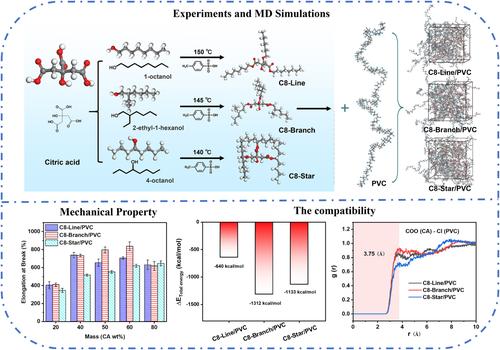当前位置:
X-MOL 学术
›
J. Appl. Polym. Sci.
›
论文详情
Our official English website, www.x-mol.net, welcomes your
feedback! (Note: you will need to create a separate account there.)
Effects of branched chains on plasticization properties of trioctyl citrate: Experiments and molecular dynamic simulations
Journal of Applied Polymer Science ( IF 2.7 ) Pub Date : 2024-07-05 , DOI: 10.1002/app.55942
Li Gao 1, 2 , Rui Yuan 2 , Chang Tu 2 , Rui Tan 2 , Shiai Xu 1, 2
Journal of Applied Polymer Science ( IF 2.7 ) Pub Date : 2024-07-05 , DOI: 10.1002/app.55942
Li Gao 1, 2 , Rui Yuan 2 , Chang Tu 2 , Rui Tan 2 , Shiai Xu 1, 2
Affiliation

|
To replace traditional phthalate plasticizers, our previous research revealed that trioctyl citrate (CA) with an alkyl chain containing 8 carbon atoms (C8) exhibited excellent plasticizing properties. In order to delve deeper into the plasticization effects of CA isomers, CA with different side-chain structures (C8-Line, C8-Branch, and C8-Star) were synthesized by esterification reactions, and various CA/polyvinyl chloride (PVC) composite films with different CA contents were prepared using a solution casting method. The plasticization mechanisms of these isomers were systematically explored through experimental and molecular dynamics simulations. The results indicate that C8-Branch demonstrates the optimal plasticizing effect, followed by C8-Line, while C8-Star exhibits poorer performance. The C8-Branch/PVC composite system displays the best plasticizing effect, attributed to the strong interaction forces between the Cl atoms of PVC and the COO groups of CA. On the contrary, the formation of stable dipole pairs between C8-Star and PVC is impeded by steric hindrance effects. The interaction between the two is predominantly dependent on the intertwining of the alkyl chains in C8-Star with the PVC chains, also elucidating the observed higher migration rate in the C8-Star/PVC system. This study provides technical guidance and theoretical basis for the optimized design of high-performance CA/PVC composites.
中文翻译:

支链对柠檬酸三辛酯塑化性能的影响:实验和分子动力学模拟
为了替代传统的邻苯二甲酸酯增塑剂,我们之前的研究表明,具有含有8个碳原子(C8)的烷基链的柠檬酸三辛酯(CA)表现出优异的增塑性能。为了更深入地研究CA异构体的增塑效果,通过酯化反应合成了不同侧链结构(C8-Line、C8-Branch和C8-Star)的CA,并制备了各种CA/聚氯乙烯(PVC)复合材料。采用溶液流延法制备了不同CA含量的薄膜。通过实验和分子动力学模拟系统地探索了这些异构体的塑化机制。结果表明,C8-Branch 的塑化效果最佳,其次是 C8-Line,而 C8-Star 的塑化效果较差。 C8-Branch/PVC复合体系表现出最好的增塑效果,这归因于PVC的Cl原子和CA的COO基团之间的强相互作用力。相反,C8-Star 和 PVC 之间稳定偶极子对的形成受到空间位阻效应的阻碍。两者之间的相互作用主要取决于 C8-Star 中的烷基链与 PVC 链的缠绕,这也说明了在 C8-Star/PVC 系统中观察到的较高迁移率。该研究为高性能CA/PVC复合材料的优化设计提供技术指导和理论依据。
更新日期:2024-07-05
中文翻译:

支链对柠檬酸三辛酯塑化性能的影响:实验和分子动力学模拟
为了替代传统的邻苯二甲酸酯增塑剂,我们之前的研究表明,具有含有8个碳原子(C8)的烷基链的柠檬酸三辛酯(CA)表现出优异的增塑性能。为了更深入地研究CA异构体的增塑效果,通过酯化反应合成了不同侧链结构(C8-Line、C8-Branch和C8-Star)的CA,并制备了各种CA/聚氯乙烯(PVC)复合材料。采用溶液流延法制备了不同CA含量的薄膜。通过实验和分子动力学模拟系统地探索了这些异构体的塑化机制。结果表明,C8-Branch 的塑化效果最佳,其次是 C8-Line,而 C8-Star 的塑化效果较差。 C8-Branch/PVC复合体系表现出最好的增塑效果,这归因于PVC的Cl原子和CA的COO基团之间的强相互作用力。相反,C8-Star 和 PVC 之间稳定偶极子对的形成受到空间位阻效应的阻碍。两者之间的相互作用主要取决于 C8-Star 中的烷基链与 PVC 链的缠绕,这也说明了在 C8-Star/PVC 系统中观察到的较高迁移率。该研究为高性能CA/PVC复合材料的优化设计提供技术指导和理论依据。































 京公网安备 11010802027423号
京公网安备 11010802027423号